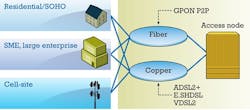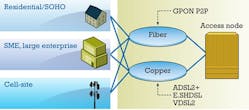By converging residential and business services over the same network, service providers can increase efficiency and reduce costs.
By Ed Harstead and Fred Willems
The surge of bandwidth-demanding residential and business services has increased relentlessly the capacity requirements in the fixed access portion of the network. To cope, most service providers have developed a shorter- or longer-term deep-fiber strategy that generally requires considerable investment. However, three strategic approaches can help service providers prepare their access network for the delivery of tomorrow's applications in a way that is cost-effective, yet opens the door to new revenue streams:
- Provide residential, business, and mobile backhaul applications on a single access platform
- Enhance and maximize service delivery to generate new revenues
- Optimize service performance and reduce the burden of bandwidth-hogging unicast video traffic on the network.
As we discuss the impact of these approaches on the access network, we will see that the first one leverages the concept of service convergence, while the other two make use of application awareness.
Figure 1. Converging residential, business, and mobile backhaul services on a single access platform that supports multiple copper and fiber last-mile options.
Benefiting from service convergence in access
The delivery of packet-based business services (including mobile backhaul) from residential access nodes is becoming a reality. Residential broadband services have evolved from best-effort, low-bandwidth applications to premium lifestyle services that are bandwidth-intensive. Hence, swift roll out and uninterrupted service delivery are critically important for operators addressing the residential segment. Interestingly, these characteristics are highly important to business customers, as well.
Service providers can benefit greatly from the integration of business users into their residential access deployments, given the related savings. These savings derive from increased operational flexibility and a simpler network design–and with multiple access technologies (copper, as well as fiber) being supported on a single platform (Figure 1). Add to this the fact that residential access has been designed right from the start with the lowest cost points in mind, and it is clear that the convergence approach will help service providers to substantially lower the cost of delivering high-value business services while leveraging the residential access network's extensive geographical reach.
So, how do we implement this convergence? What capabilities are needed to turn access into converged access? And, more importantly, are these capabilities readily available? The Metro Ethernet Forum (MEF) considerations in Table 1 help answer these questions.
By way of example, let's discuss these considerations within the context of mobile backhaul. As mobile service providers deploy 3G networks, wireless broadband service adoption rapidly strains the traditional, voice-optimized, TDM mobile backhaul infrastructure, which does not cost-effectively scale to handle exponential increases in data traffic. The need for a packet-based approach has become clear, and the success of LTE will depend on it.
The requirements for the successful delivery of Ethernet business services listed in Table 1 generally apply for packet-based mobile backhaul, as well. Three additional needs must be taken into account, however–all met by today's broadband access networks:
- Mobile broadband is driving the rapidly increasing demand for (mostly asymmetrical) bandwidth. Answering this requirement, ADSL2+ and SHDSL are excellent tactical solutions for near-term 3G bandwidth relief. Long-term strategic solutions for 3G and LTE include VDSL2 with multi-pair bonding (capable of delivering hundreds of Mbps) and GPON and point-to-point fiber (supporting 1 Gbps and more).
- A typical cell site will have mixed 2G/3G (and eventually LTE) radio technologies, requiring not only Ethernet backhaul but also TDM backhaul. Today's broadband access networks are capable of backhauling TDM over pseudowires.
- Cell-site radio equipment requires an accurate clock to set its RF frequencies in support of call hand-overs. GPON, point-to-point fiber, and xDSL networks can cope with this need using standards-based line synchronization.
Leveraging application awareness in access
The access part of the network has been subject to several rounds of major investments, first in ADSL technology to support high-speed Internet access, and more recently in "fiber to the most economic point" to enable the delivery of full triple-play services.
So far, innovation has mainly focused on providing lower-cost, higher-speed transport mechanisms while minimizing the operating expenditures (opex) of installation and management. Application awareness and functionality have traditionally been integrated into the aggregation and core network elements. However, an access node, due to its unique location closest to the subscriber and best knowledge of last-mile bandwidth utilization, is ideally suited to support many "application aware"-related features. As such, the access node's application awareness should play an increasingly important role in creating more value for the access network. Let's investigate some use cases.
Dynamically controlling access to bandwidth–"turbo boost." On-demand bandwidth boosts are useful for all types of Internet services, such as file downloads, Web browsing, or video. Through the so-called turbo boost functionality, end-users could request a temporary increase of bandwidth–both in the downstream and upstream directions, and with any boost quota checked through (local) admission control. If the current traffic from, for example, a video-on-demand or broadcast-TV session is leaving enough bandwidth for the boost, local policies on the access node can be adapted to enable the boost for a specified time.
For this to work, an end-to-end approach is required–because both the access and the transport pieces of the network are potential bottlenecks. And, as just mentioned, that is where (local) resource admission control (RAC) comes into play. The RAC function takes into account the resources as reported by the packet transport network, as well as those from the local RAC of the access node. To enable this, a new policy-management interface between the access node and the central RAC is required. Additionally, if a service is admitted to the network, this service must also get a guaranteed bandwidth in both downstream and upstream directions through policy enforcement.
Optimizing content delivery with caching. In a triple-play access network, managed IPTV traffic normally consumes the greatest amount of bandwidth (compared to voice and high-speed Internet access). Upstream of the access node–as one moves farther from the end-user–IPTV traffic becomes proportionally smaller, however, because IPTV channels are multicast at every network element.
Whereas multicasting can offload the service providers' network, we see that in practice IPTV traffic is often converted to unicast streams to improve quality of experience. This conversion enables features, such as IPTV retransmission, fast channel change, and network-based IPTV digital video recording. Luckily, the burden brought by this unicast traffic on the operator's network can be alleviated by localized caching.
The underlying principle is simple: Costs are minimized when less popular content is stored in fewer, more centrally located caches, while the more popular content with higher hit rates is placed in a larger number of caches closer to the end-users. With the cost of storage dropping much faster than transport costs, it starts to make economic sense to provide cache capability at the furthest edges of the network, including the access node. As such, mass-market demand for content can be met without burdening a service provider's network with significant volumes of duplicated unicast content.
Similarly, Internet traffic (which is always unicast), can place a large demand on the operator's network as well–which is becoming more acute with the rise of over-the-top video services (provided by YouTube or Hulu, for instance) and the broadcast of live sporting events. Again, a content delivery network (Figure 2) with distributed caches minimizes the costs of delivering streaming content and provides operators with a way to cost-effectively offload their networks.
Accessing more revenue
We have described two concepts that are essential for service providers to derive more revenue out of their (access) networks while optimizing bandwidth usage–two concepts that help them shape today's access networks to support tomorrow's applications.
The first one, service convergence, enables the delivery of business, mobile backhaul, and residential services from the same platform and accommodates copper as well as fiber access. This is made possible by leveraging the inherent capabilities of the residential triple-play network and by applying Carrier Ethernet technology that used to be available only in dedicated business access platforms.
The second approach leverages application awareness in the access node. One example is using RAC directly on the access node, which enables service providers to use the available bandwidth in a way that makes the most sense economically. Another example is caching, which accommodates the mass market demand for content without burdening an operator's network with significant volumes of duplicated unicast traffic. A fully optimized caching strategy that takes advantage of the rapidly diminishing cost of storage will include caching distributed across core, aggregation, and access nodes.
Table 1: Residential/business convergence considerations.
Requirement | Solution | Availability |
The delivery of very high bandwidths and symmetrical services from a single access platform–supporting copper and fiber | Very high bandwidths and symmetrical services can be delivered over bonded SHDSL and VDSL2, point-to-point fiber, and GPON–from the same access node | √ |
Service-level agreements to deliver end-to-end performance | A software and hardware architecture on both the CPE and access node that is capable of classifying a service by looking at, for example, the IP header, and then subsequently providing the proper quality of service by queuing and scheduling the packets | √ |
Scaling the number of users | Using either "pure" Ethernet (leveraging, for example, IEEE 802.1ad-based VLAN stacking) or (maybe even better) using MPLS label stacking for even more flexibility | √ |
Providing geographical flexibility (i.e., delivering services anywhere) | This requirement is inherent to residential access–as it supports a multitude of last-mile technology choices (covering fiber and copper) and having a large geographical coverage already | √ |
Monitoring the network and diagnosing the root cause of failures | Based on the protocols defined by IEEE, such as 802.3ah and 802.1ag, for operation and maintenance (OAM) purposes on the physical link layers and the Ethernet service layer | √ |
Detecting failures in the network and recovering from them | MPLS and Ethernet-based protection and restoration to ensure there is no impact on the users' service experience | √ |
Ed Harstead and Fred Willems are members of the Wireline Division product marketing team at Alcatel-Lucent.
Past LW Issues


